Waterfront and Shoreline Case Study: Cottage Expansion Variance Report
VerifiedAdded on 2023/01/13
|9
|2326
|73
Report
AI Summary
This report presents a case study analysis of a waterfront property undergoing a cottage expansion, focusing on the application of minor variance principles. The study examines the property's location within Ecoregion 5E, near Woodlands and South Robbins Island, and assesses the expansion's compliance with zoning by-laws and official plans. It delves into the nature of the minor variance, its desirability and appropriateness for the area, and its alignment with the intent of the official plan. The report considers the environmental impact, particularly concerning the natural heritage system and the shoreline. Key aspects include building setbacks, water level considerations, and the overall impact on the surrounding environment. The analysis highlights how the expansion meets the four tests of a minor variance, ensuring minimal environmental disruption and adherence to zoning regulations. Furthermore, the report discusses the watershed-based strategic approach and its components, emphasizing the importance of environmental conservation and sustainable development in the context of waterfront properties.

Waterfront and Shoreline Case Study
Name
Course
Lecturer
Institution
Name
Course
Lecturer
Institution
Paraphrase This Document
Need a fresh take? Get an instant paraphrase of this document with our AI Paraphraser
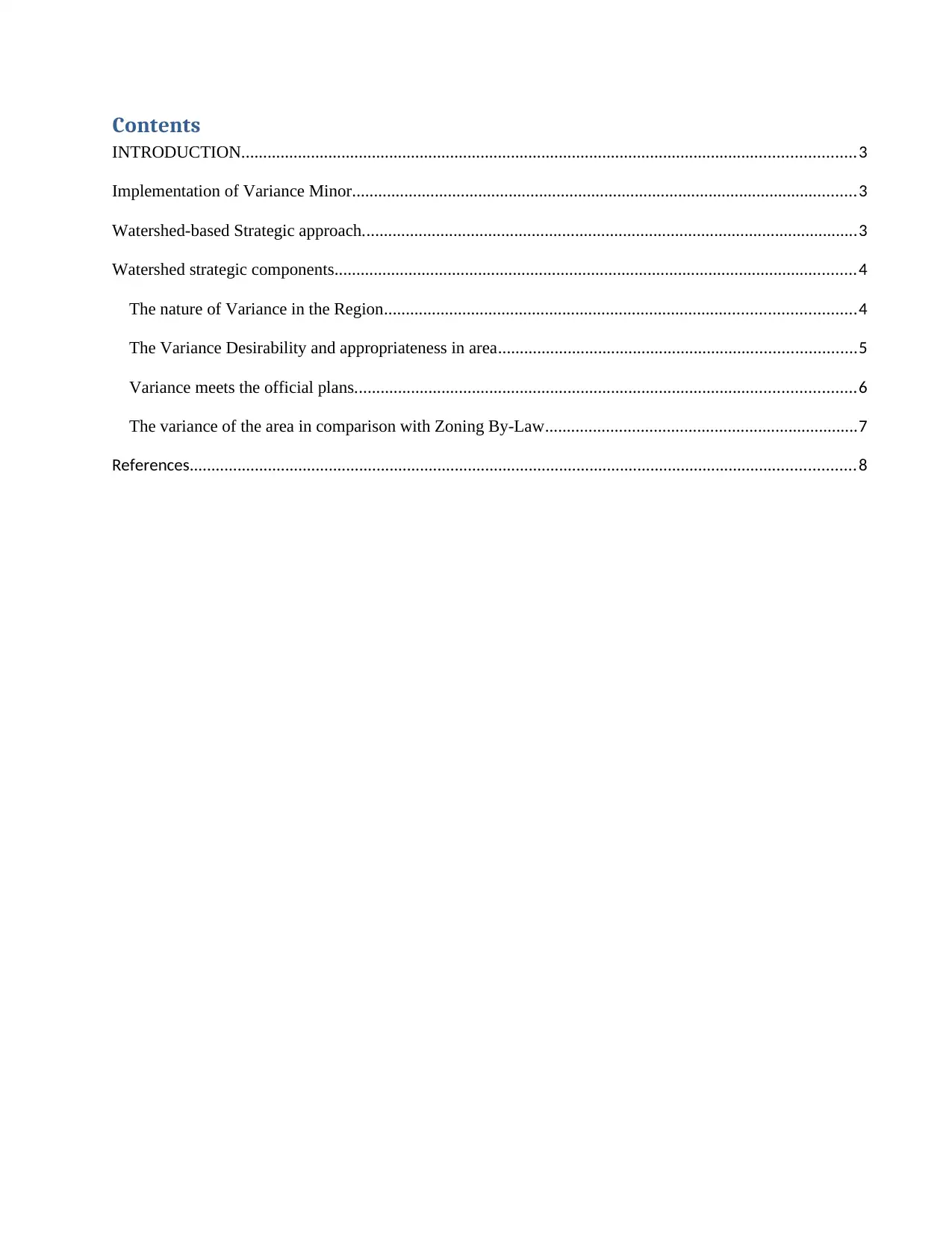
Contents
INTRODUCTION.............................................................................................................................................3
Implementation of Variance Minor....................................................................................................................3
Watershed-based Strategic approach..................................................................................................................3
Watershed strategic components........................................................................................................................4
The nature of Variance in the Region............................................................................................................4
The Variance Desirability and appropriateness in area..................................................................................5
Variance meets the official plans...................................................................................................................6
The variance of the area in comparison with Zoning By-Law........................................................................7
References.........................................................................................................................................................8
INTRODUCTION.............................................................................................................................................3
Implementation of Variance Minor....................................................................................................................3
Watershed-based Strategic approach..................................................................................................................3
Watershed strategic components........................................................................................................................4
The nature of Variance in the Region............................................................................................................4
The Variance Desirability and appropriateness in area..................................................................................5
Variance meets the official plans...................................................................................................................6
The variance of the area in comparison with Zoning By-Law........................................................................7
References.........................................................................................................................................................8
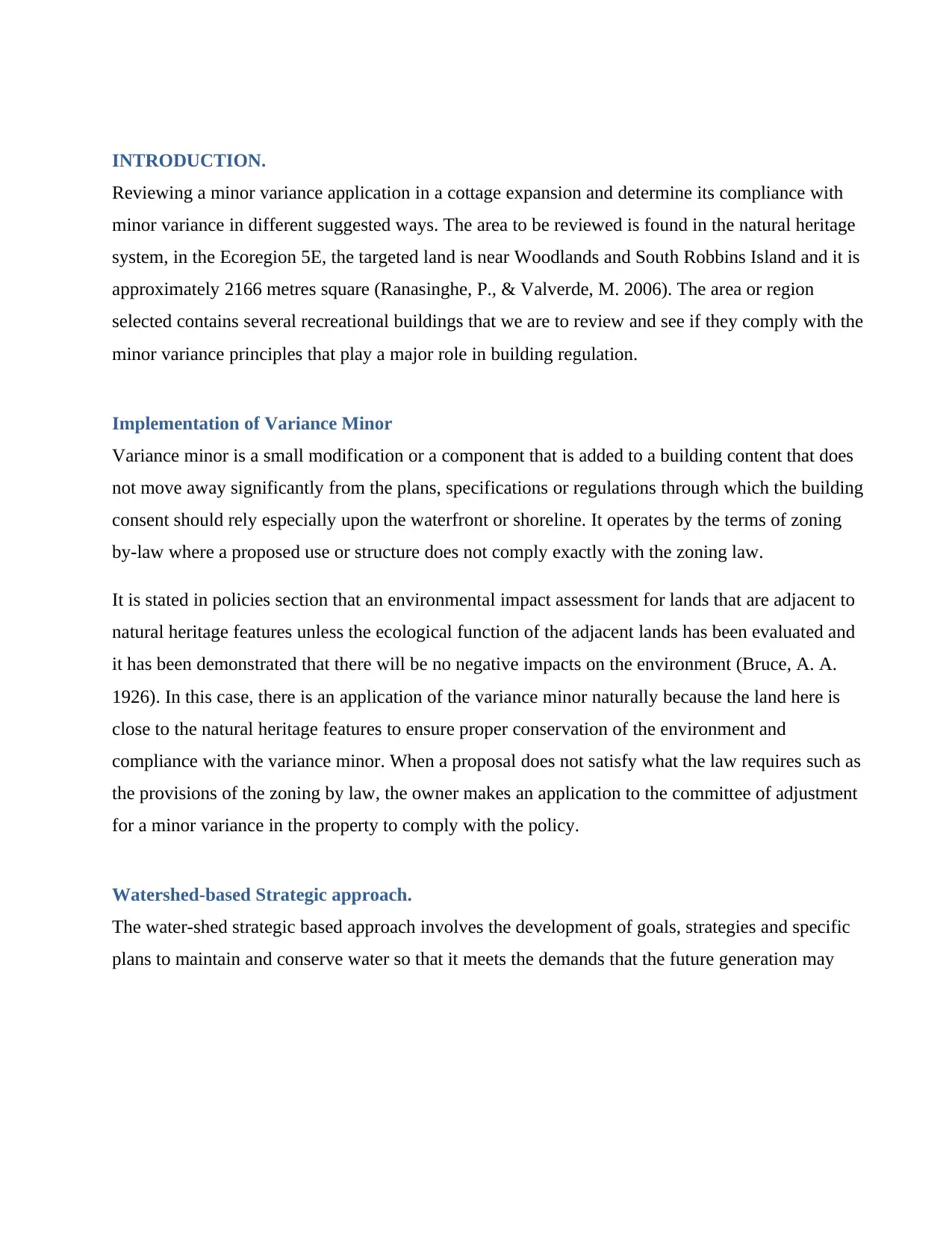
INTRODUCTION.
Reviewing a minor variance application in a cottage expansion and determine its compliance with
minor variance in different suggested ways. The area to be reviewed is found in the natural heritage
system, in the Ecoregion 5E, the targeted land is near Woodlands and South Robbins Island and it is
approximately 2166 metres square (Ranasinghe, P., & Valverde, M. 2006). The area or region
selected contains several recreational buildings that we are to review and see if they comply with the
minor variance principles that play a major role in building regulation.
Implementation of Variance Minor
Variance minor is a small modification or a component that is added to a building content that does
not move away significantly from the plans, specifications or regulations through which the building
consent should rely especially upon the waterfront or shoreline. It operates by the terms of zoning
by-law where a proposed use or structure does not comply exactly with the zoning law.
It is stated in policies section that an environmental impact assessment for lands that are adjacent to
natural heritage features unless the ecological function of the adjacent lands has been evaluated and
it has been demonstrated that there will be no negative impacts on the environment (Bruce, A. A.
1926). In this case, there is an application of the variance minor naturally because the land here is
close to the natural heritage features to ensure proper conservation of the environment and
compliance with the variance minor. When a proposal does not satisfy what the law requires such as
the provisions of the zoning by law, the owner makes an application to the committee of adjustment
for a minor variance in the property to comply with the policy.
Watershed-based Strategic approach.
The water-shed strategic based approach involves the development of goals, strategies and specific
plans to maintain and conserve water so that it meets the demands that the future generation may
Reviewing a minor variance application in a cottage expansion and determine its compliance with
minor variance in different suggested ways. The area to be reviewed is found in the natural heritage
system, in the Ecoregion 5E, the targeted land is near Woodlands and South Robbins Island and it is
approximately 2166 metres square (Ranasinghe, P., & Valverde, M. 2006). The area or region
selected contains several recreational buildings that we are to review and see if they comply with the
minor variance principles that play a major role in building regulation.
Implementation of Variance Minor
Variance minor is a small modification or a component that is added to a building content that does
not move away significantly from the plans, specifications or regulations through which the building
consent should rely especially upon the waterfront or shoreline. It operates by the terms of zoning
by-law where a proposed use or structure does not comply exactly with the zoning law.
It is stated in policies section that an environmental impact assessment for lands that are adjacent to
natural heritage features unless the ecological function of the adjacent lands has been evaluated and
it has been demonstrated that there will be no negative impacts on the environment (Bruce, A. A.
1926). In this case, there is an application of the variance minor naturally because the land here is
close to the natural heritage features to ensure proper conservation of the environment and
compliance with the variance minor. When a proposal does not satisfy what the law requires such as
the provisions of the zoning by law, the owner makes an application to the committee of adjustment
for a minor variance in the property to comply with the policy.
Watershed-based Strategic approach.
The water-shed strategic based approach involves the development of goals, strategies and specific
plans to maintain and conserve water so that it meets the demands that the future generation may
⊘ This is a preview!⊘
Do you want full access?
Subscribe today to unlock all pages.

Trusted by 1+ million students worldwide

demand Aro, (H. T., & Koivunen, T. 1991). Watershed plan establishes solutions to critical issues
they are encountering in the current world. Their strategic approach includes:
Determining solutions to the available conditions that might not be moving in the right
direction
Identifies the problems that are affecting the water bodies and the environment in general
After identifying the problems, they move forward and develop relevant solutions to the
problems
It also emphasizes on the restoration and physical improvement to makes sure that the
environment is conserved well and adhered to, to make sure the future generations get an
unpolluted environment
Stormwater management and urban NPS to avoid unnecessary loss of lives, property and
destruction of the ecosystem
They also emphasize on the protection to relatively good water to make sure its quality is
maintained
These are the plans of the water shade that defines their rationale and administration plans in
approach to solving issues arising about the watershed and other related.
Watershed strategic components
Watersheds are just spatially landscape units that have many things interacting such as physical,
ecological and social attributes. It provides a range of ecosystem services that are valued by the
society such as soil formation, nutrients, primary production provision of good services, this all is
available in the case study area.
Therefore in observing the above requirements of the minor variance, we examined the area and see
how the application meets the four tests of minor variance.
they are encountering in the current world. Their strategic approach includes:
Determining solutions to the available conditions that might not be moving in the right
direction
Identifies the problems that are affecting the water bodies and the environment in general
After identifying the problems, they move forward and develop relevant solutions to the
problems
It also emphasizes on the restoration and physical improvement to makes sure that the
environment is conserved well and adhered to, to make sure the future generations get an
unpolluted environment
Stormwater management and urban NPS to avoid unnecessary loss of lives, property and
destruction of the ecosystem
They also emphasize on the protection to relatively good water to make sure its quality is
maintained
These are the plans of the water shade that defines their rationale and administration plans in
approach to solving issues arising about the watershed and other related.
Watershed strategic components
Watersheds are just spatially landscape units that have many things interacting such as physical,
ecological and social attributes. It provides a range of ecosystem services that are valued by the
society such as soil formation, nutrients, primary production provision of good services, this all is
available in the case study area.
Therefore in observing the above requirements of the minor variance, we examined the area and see
how the application meets the four tests of minor variance.
Paraphrase This Document
Need a fresh take? Get an instant paraphrase of this document with our AI Paraphraser
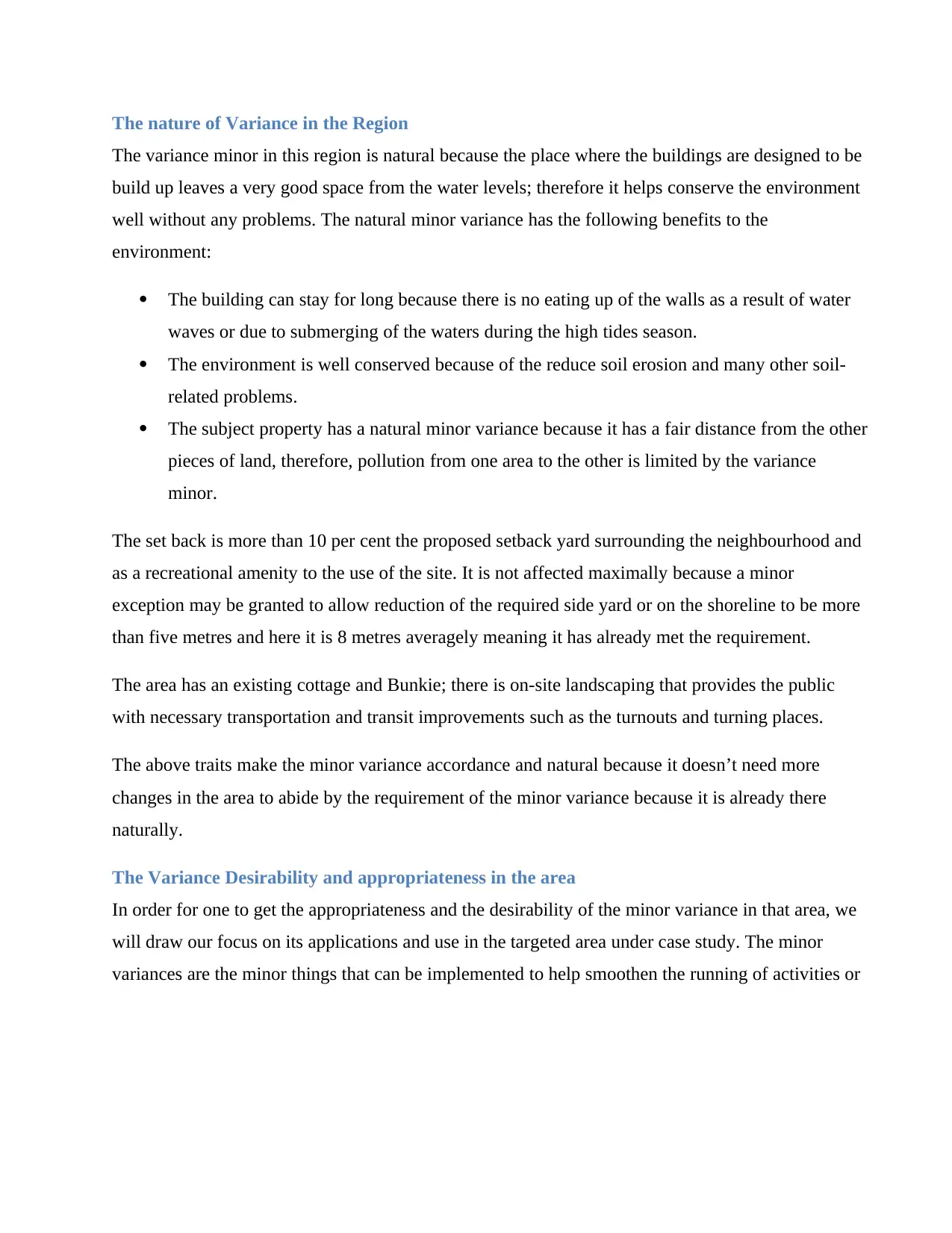
The nature of Variance in the Region
The variance minor in this region is natural because the place where the buildings are designed to be
build up leaves a very good space from the water levels; therefore it helps conserve the environment
well without any problems. The natural minor variance has the following benefits to the
environment:
The building can stay for long because there is no eating up of the walls as a result of water
waves or due to submerging of the waters during the high tides season.
The environment is well conserved because of the reduce soil erosion and many other soil-
related problems.
The subject property has a natural minor variance because it has a fair distance from the other
pieces of land, therefore, pollution from one area to the other is limited by the variance
minor.
The set back is more than 10 per cent the proposed setback yard surrounding the neighbourhood and
as a recreational amenity to the use of the site. It is not affected maximally because a minor
exception may be granted to allow reduction of the required side yard or on the shoreline to be more
than five metres and here it is 8 metres averagely meaning it has already met the requirement.
The area has an existing cottage and Bunkie; there is on-site landscaping that provides the public
with necessary transportation and transit improvements such as the turnouts and turning places.
The above traits make the minor variance accordance and natural because it doesn’t need more
changes in the area to abide by the requirement of the minor variance because it is already there
naturally.
The Variance Desirability and appropriateness in the area
In order for one to get the appropriateness and the desirability of the minor variance in that area, we
will draw our focus on its applications and use in the targeted area under case study. The minor
variances are the minor things that can be implemented to help smoothen the running of activities or
The variance minor in this region is natural because the place where the buildings are designed to be
build up leaves a very good space from the water levels; therefore it helps conserve the environment
well without any problems. The natural minor variance has the following benefits to the
environment:
The building can stay for long because there is no eating up of the walls as a result of water
waves or due to submerging of the waters during the high tides season.
The environment is well conserved because of the reduce soil erosion and many other soil-
related problems.
The subject property has a natural minor variance because it has a fair distance from the other
pieces of land, therefore, pollution from one area to the other is limited by the variance
minor.
The set back is more than 10 per cent the proposed setback yard surrounding the neighbourhood and
as a recreational amenity to the use of the site. It is not affected maximally because a minor
exception may be granted to allow reduction of the required side yard or on the shoreline to be more
than five metres and here it is 8 metres averagely meaning it has already met the requirement.
The area has an existing cottage and Bunkie; there is on-site landscaping that provides the public
with necessary transportation and transit improvements such as the turnouts and turning places.
The above traits make the minor variance accordance and natural because it doesn’t need more
changes in the area to abide by the requirement of the minor variance because it is already there
naturally.
The Variance Desirability and appropriateness in the area
In order for one to get the appropriateness and the desirability of the minor variance in that area, we
will draw our focus on its applications and use in the targeted area under case study. The minor
variances are the minor things that can be implemented to help smoothen the running of activities or

the conserving the environment (Tennes, K., & Blackard, C. 1980). The following determines/
shows the appropriateness of the variance employed in the area:
Building set back that is employed there for example from the Bunkie to the cottage helps in
free movement and also allows freedom inflow of activities such as loud music in the Bunkie
won't affect the activities in the cottage because noise won’t reach there.
The huge indent that is between the water and the building enables the activity to flow
continuously as high and low tides won’t affect the area. Also, waves and other strong waves
such as tsunami and hurricanes will not reach the place easily and destroy the houses or even
the lives of people living around.
Their big space that is an occupied enables or provides storage of temporary, also provides
enough parking of vehicles and boats if present, therefore this ensures that there will be no
unnecessary congestion of either people or material in the area in normal occasions.
The height of the building is well observed that helps in maintaining the aeration of the
building as buildings that are extremely short gets heated faster thus having higher
temperatures that bring inconvenience when staying in that building during hot
times/summer.
This shows that variance in this area is desirable and appropriate to the people staying in this area
because it is full of advantages. Variance, although minor as it is, it helps people a lot by offering
simple solutions to simple problems also complex included. Therefore, a variance is very appropriate
and desirable to the targeted area of the case study.
Variance meets the official plans.
The variance here meets the official plan that was designed previously in this region. One of the
major factors that contributed to the matching of the variance and the intent of the official plan is
that the place has no many buildings or services; therefore, it was designed properly (Schwartz, J., &
Otto, D. 1991). The minor variance meets the intent of the official plan. Variance meeting the intent
of the official plan is not common because most people who prepare the plans do not focus too much
shows the appropriateness of the variance employed in the area:
Building set back that is employed there for example from the Bunkie to the cottage helps in
free movement and also allows freedom inflow of activities such as loud music in the Bunkie
won't affect the activities in the cottage because noise won’t reach there.
The huge indent that is between the water and the building enables the activity to flow
continuously as high and low tides won’t affect the area. Also, waves and other strong waves
such as tsunami and hurricanes will not reach the place easily and destroy the houses or even
the lives of people living around.
Their big space that is an occupied enables or provides storage of temporary, also provides
enough parking of vehicles and boats if present, therefore this ensures that there will be no
unnecessary congestion of either people or material in the area in normal occasions.
The height of the building is well observed that helps in maintaining the aeration of the
building as buildings that are extremely short gets heated faster thus having higher
temperatures that bring inconvenience when staying in that building during hot
times/summer.
This shows that variance in this area is desirable and appropriate to the people staying in this area
because it is full of advantages. Variance, although minor as it is, it helps people a lot by offering
simple solutions to simple problems also complex included. Therefore, a variance is very appropriate
and desirable to the targeted area of the case study.
Variance meets the official plans.
The variance here meets the official plan that was designed previously in this region. One of the
major factors that contributed to the matching of the variance and the intent of the official plan is
that the place has no many buildings or services; therefore, it was designed properly (Schwartz, J., &
Otto, D. 1991). The minor variance meets the intent of the official plan. Variance meeting the intent
of the official plan is not common because most people who prepare the plans do not focus too much
⊘ This is a preview!⊘
Do you want full access?
Subscribe today to unlock all pages.

Trusted by 1+ million students worldwide
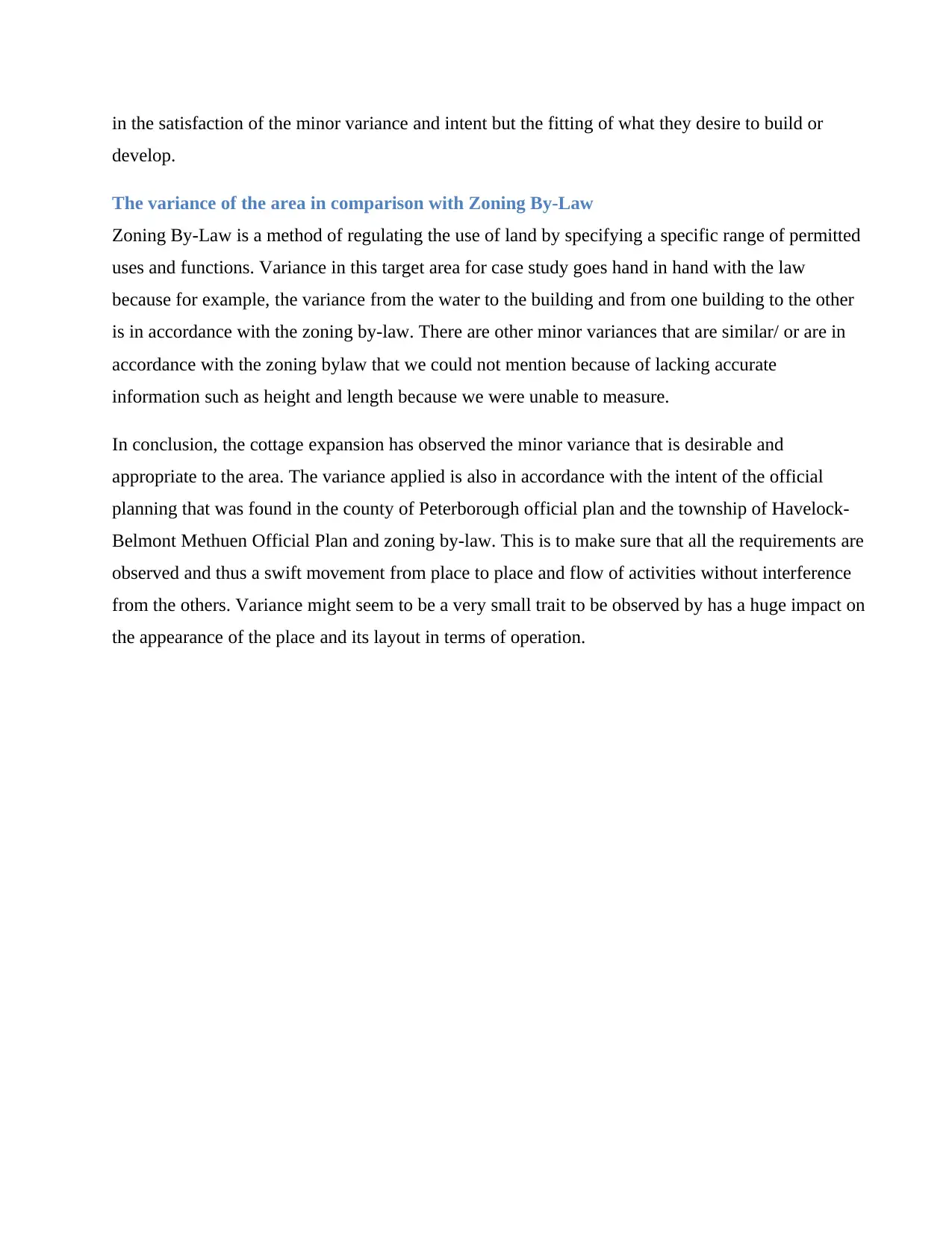
in the satisfaction of the minor variance and intent but the fitting of what they desire to build or
develop.
The variance of the area in comparison with Zoning By-Law
Zoning By-Law is a method of regulating the use of land by specifying a specific range of permitted
uses and functions. Variance in this target area for case study goes hand in hand with the law
because for example, the variance from the water to the building and from one building to the other
is in accordance with the zoning by-law. There are other minor variances that are similar/ or are in
accordance with the zoning bylaw that we could not mention because of lacking accurate
information such as height and length because we were unable to measure.
In conclusion, the cottage expansion has observed the minor variance that is desirable and
appropriate to the area. The variance applied is also in accordance with the intent of the official
planning that was found in the county of Peterborough official plan and the township of Havelock-
Belmont Methuen Official Plan and zoning by-law. This is to make sure that all the requirements are
observed and thus a swift movement from place to place and flow of activities without interference
from the others. Variance might seem to be a very small trait to be observed by has a huge impact on
the appearance of the place and its layout in terms of operation.
develop.
The variance of the area in comparison with Zoning By-Law
Zoning By-Law is a method of regulating the use of land by specifying a specific range of permitted
uses and functions. Variance in this target area for case study goes hand in hand with the law
because for example, the variance from the water to the building and from one building to the other
is in accordance with the zoning by-law. There are other minor variances that are similar/ or are in
accordance with the zoning bylaw that we could not mention because of lacking accurate
information such as height and length because we were unable to measure.
In conclusion, the cottage expansion has observed the minor variance that is desirable and
appropriate to the area. The variance applied is also in accordance with the intent of the official
planning that was found in the county of Peterborough official plan and the township of Havelock-
Belmont Methuen Official Plan and zoning by-law. This is to make sure that all the requirements are
observed and thus a swift movement from place to place and flow of activities without interference
from the others. Variance might seem to be a very small trait to be observed by has a huge impact on
the appearance of the place and its layout in terms of operation.
Paraphrase This Document
Need a fresh take? Get an instant paraphrase of this document with our AI Paraphraser
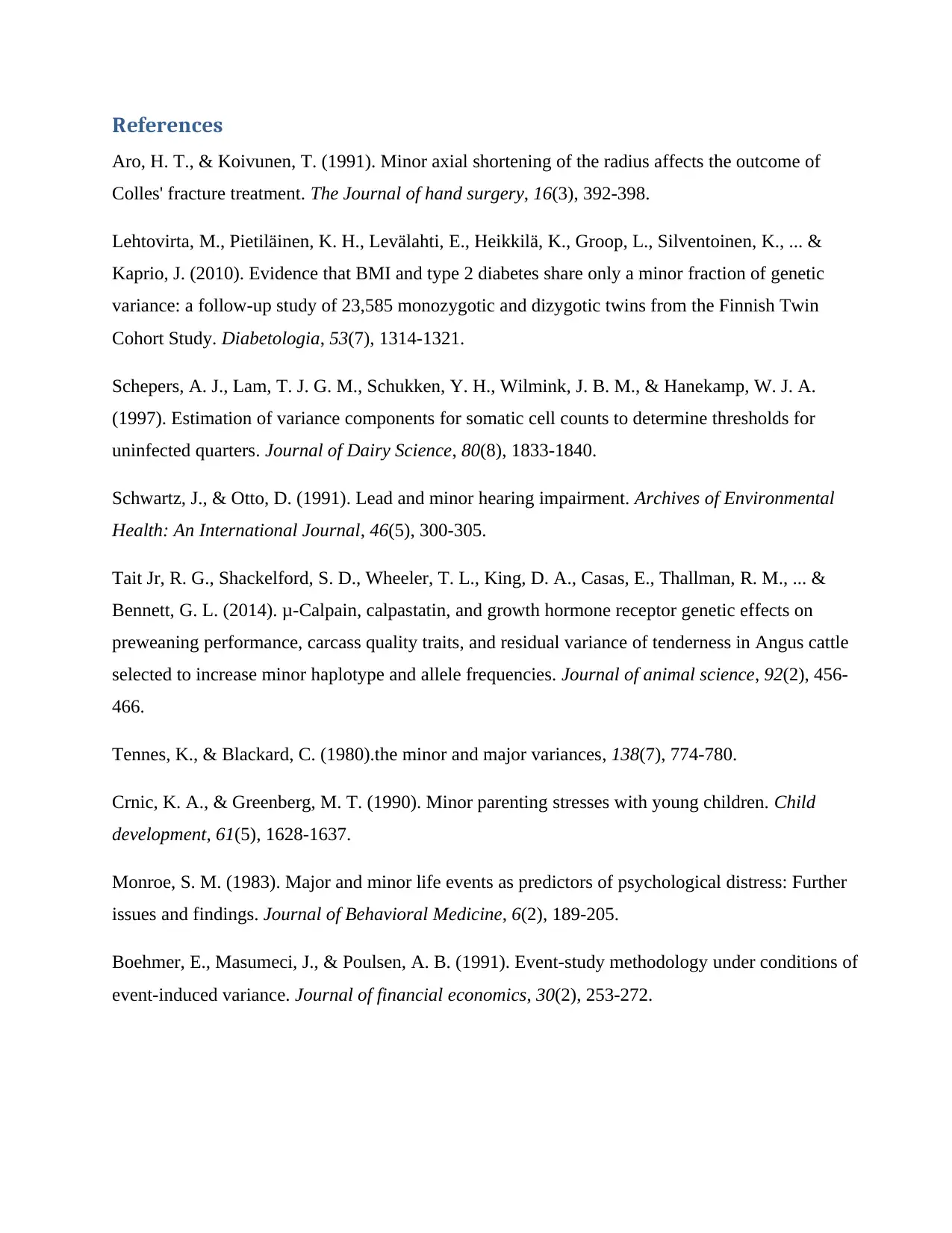
References
Aro, H. T., & Koivunen, T. (1991). Minor axial shortening of the radius affects the outcome of
Colles' fracture treatment. The Journal of hand surgery, 16(3), 392-398.
Lehtovirta, M., Pietiläinen, K. H., Levälahti, E., Heikkilä, K., Groop, L., Silventoinen, K., ... &
Kaprio, J. (2010). Evidence that BMI and type 2 diabetes share only a minor fraction of genetic
variance: a follow-up study of 23,585 monozygotic and dizygotic twins from the Finnish Twin
Cohort Study. Diabetologia, 53(7), 1314-1321.
Schepers, A. J., Lam, T. J. G. M., Schukken, Y. H., Wilmink, J. B. M., & Hanekamp, W. J. A.
(1997). Estimation of variance components for somatic cell counts to determine thresholds for
uninfected quarters. Journal of Dairy Science, 80(8), 1833-1840.
Schwartz, J., & Otto, D. (1991). Lead and minor hearing impairment. Archives of Environmental
Health: An International Journal, 46(5), 300-305.
Tait Jr, R. G., Shackelford, S. D., Wheeler, T. L., King, D. A., Casas, E., Thallman, R. M., ... &
Bennett, G. L. (2014). μ-Calpain, calpastatin, and growth hormone receptor genetic effects on
preweaning performance, carcass quality traits, and residual variance of tenderness in Angus cattle
selected to increase minor haplotype and allele frequencies. Journal of animal science, 92(2), 456-
466.
Tennes, K., & Blackard, C. (1980).the minor and major variances, 138(7), 774-780.
Crnic, K. A., & Greenberg, M. T. (1990). Minor parenting stresses with young children. Child
development, 61(5), 1628-1637.
Monroe, S. M. (1983). Major and minor life events as predictors of psychological distress: Further
issues and findings. Journal of Behavioral Medicine, 6(2), 189-205.
Boehmer, E., Masumeci, J., & Poulsen, A. B. (1991). Event-study methodology under conditions of
event-induced variance. Journal of financial economics, 30(2), 253-272.
Aro, H. T., & Koivunen, T. (1991). Minor axial shortening of the radius affects the outcome of
Colles' fracture treatment. The Journal of hand surgery, 16(3), 392-398.
Lehtovirta, M., Pietiläinen, K. H., Levälahti, E., Heikkilä, K., Groop, L., Silventoinen, K., ... &
Kaprio, J. (2010). Evidence that BMI and type 2 diabetes share only a minor fraction of genetic
variance: a follow-up study of 23,585 monozygotic and dizygotic twins from the Finnish Twin
Cohort Study. Diabetologia, 53(7), 1314-1321.
Schepers, A. J., Lam, T. J. G. M., Schukken, Y. H., Wilmink, J. B. M., & Hanekamp, W. J. A.
(1997). Estimation of variance components for somatic cell counts to determine thresholds for
uninfected quarters. Journal of Dairy Science, 80(8), 1833-1840.
Schwartz, J., & Otto, D. (1991). Lead and minor hearing impairment. Archives of Environmental
Health: An International Journal, 46(5), 300-305.
Tait Jr, R. G., Shackelford, S. D., Wheeler, T. L., King, D. A., Casas, E., Thallman, R. M., ... &
Bennett, G. L. (2014). μ-Calpain, calpastatin, and growth hormone receptor genetic effects on
preweaning performance, carcass quality traits, and residual variance of tenderness in Angus cattle
selected to increase minor haplotype and allele frequencies. Journal of animal science, 92(2), 456-
466.
Tennes, K., & Blackard, C. (1980).the minor and major variances, 138(7), 774-780.
Crnic, K. A., & Greenberg, M. T. (1990). Minor parenting stresses with young children. Child
development, 61(5), 1628-1637.
Monroe, S. M. (1983). Major and minor life events as predictors of psychological distress: Further
issues and findings. Journal of Behavioral Medicine, 6(2), 189-205.
Boehmer, E., Masumeci, J., & Poulsen, A. B. (1991). Event-study methodology under conditions of
event-induced variance. Journal of financial economics, 30(2), 253-272.
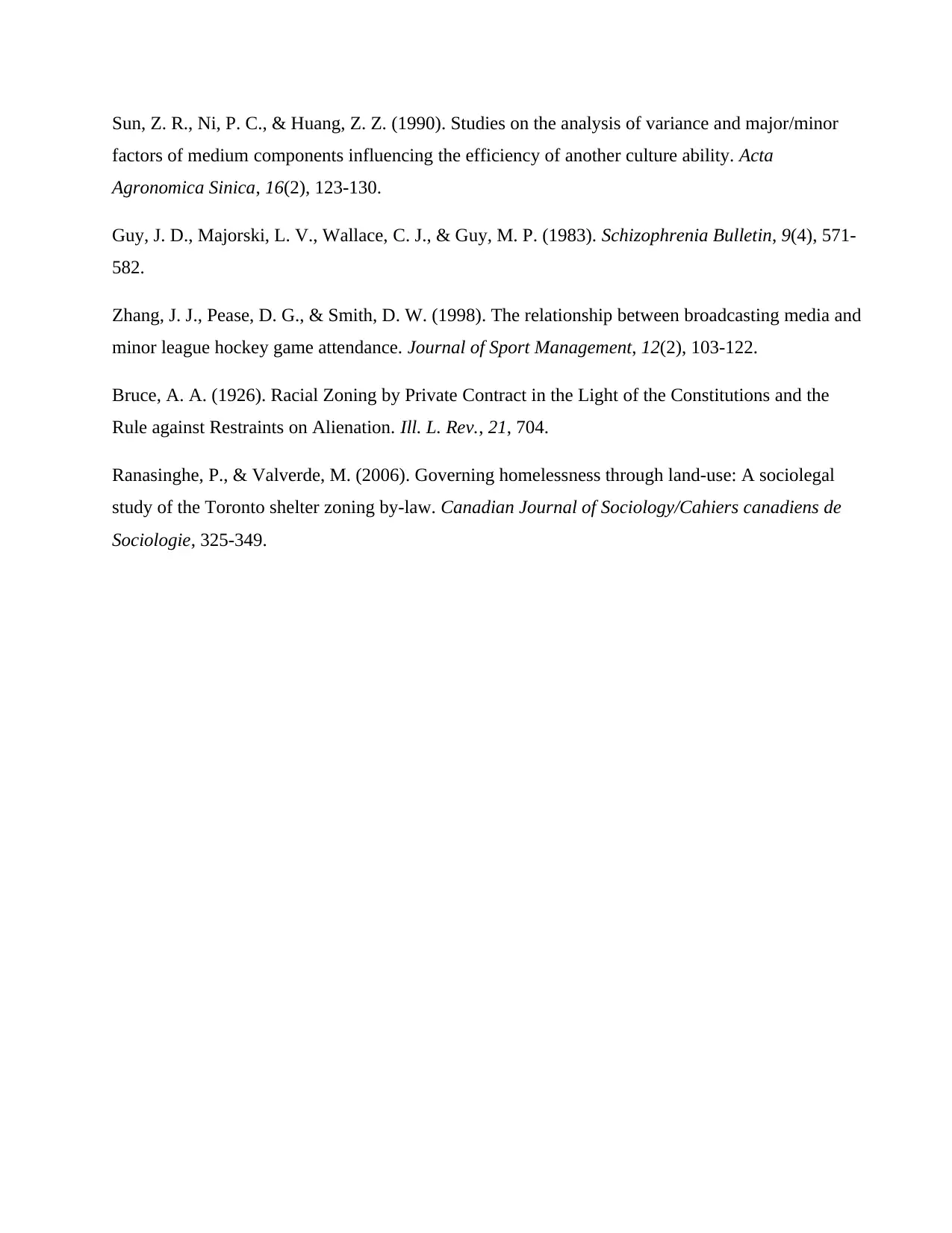
Sun, Z. R., Ni, P. C., & Huang, Z. Z. (1990). Studies on the analysis of variance and major/minor
factors of medium components influencing the efficiency of another culture ability. Acta
Agronomica Sinica, 16(2), 123-130.
Guy, J. D., Majorski, L. V., Wallace, C. J., & Guy, M. P. (1983). Schizophrenia Bulletin, 9(4), 571-
582.
Zhang, J. J., Pease, D. G., & Smith, D. W. (1998). The relationship between broadcasting media and
minor league hockey game attendance. Journal of Sport Management, 12(2), 103-122.
Bruce, A. A. (1926). Racial Zoning by Private Contract in the Light of the Constitutions and the
Rule against Restraints on Alienation. Ill. L. Rev., 21, 704.
Ranasinghe, P., & Valverde, M. (2006). Governing homelessness through land-use: A sociolegal
study of the Toronto shelter zoning by-law. Canadian Journal of Sociology/Cahiers canadiens de
Sociologie, 325-349.
factors of medium components influencing the efficiency of another culture ability. Acta
Agronomica Sinica, 16(2), 123-130.
Guy, J. D., Majorski, L. V., Wallace, C. J., & Guy, M. P. (1983). Schizophrenia Bulletin, 9(4), 571-
582.
Zhang, J. J., Pease, D. G., & Smith, D. W. (1998). The relationship between broadcasting media and
minor league hockey game attendance. Journal of Sport Management, 12(2), 103-122.
Bruce, A. A. (1926). Racial Zoning by Private Contract in the Light of the Constitutions and the
Rule against Restraints on Alienation. Ill. L. Rev., 21, 704.
Ranasinghe, P., & Valverde, M. (2006). Governing homelessness through land-use: A sociolegal
study of the Toronto shelter zoning by-law. Canadian Journal of Sociology/Cahiers canadiens de
Sociologie, 325-349.
⊘ This is a preview!⊘
Do you want full access?
Subscribe today to unlock all pages.

Trusted by 1+ million students worldwide
1 out of 9
Your All-in-One AI-Powered Toolkit for Academic Success.
+13062052269
info@desklib.com
Available 24*7 on WhatsApp / Email
![[object Object]](/_next/static/media/star-bottom.7253800d.svg)
Unlock your academic potential
Copyright © 2020–2025 A2Z Services. All Rights Reserved. Developed and managed by ZUCOL.